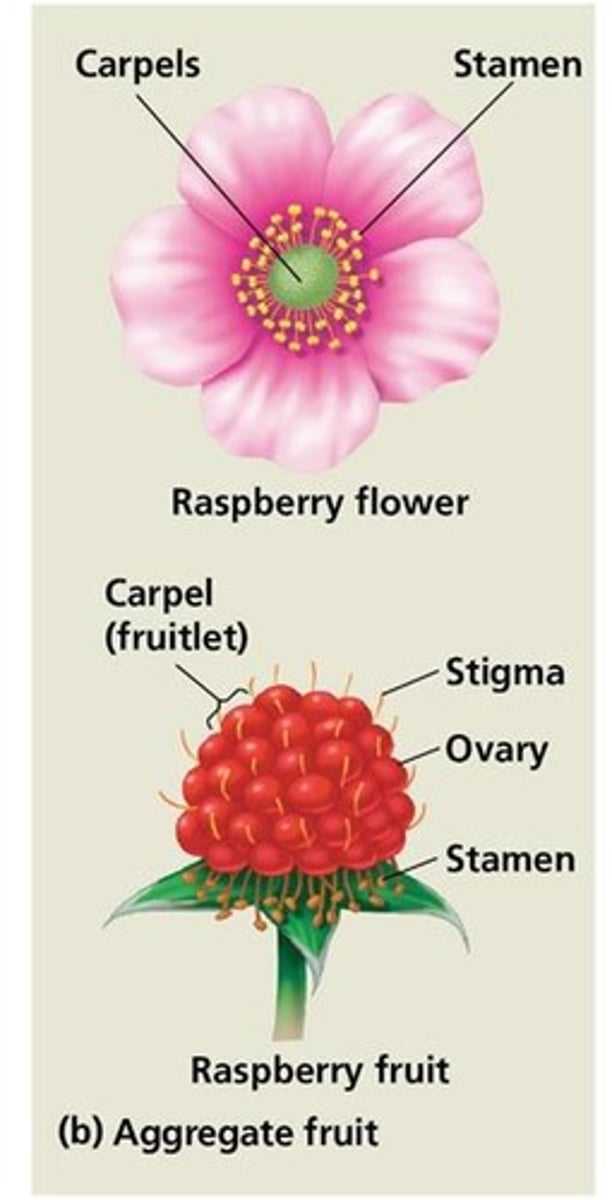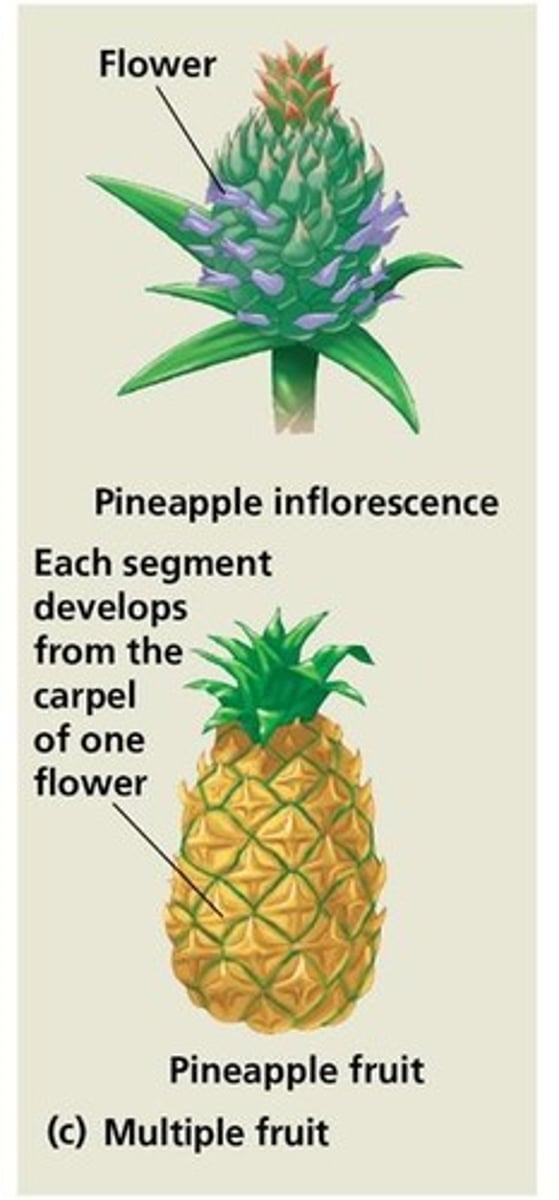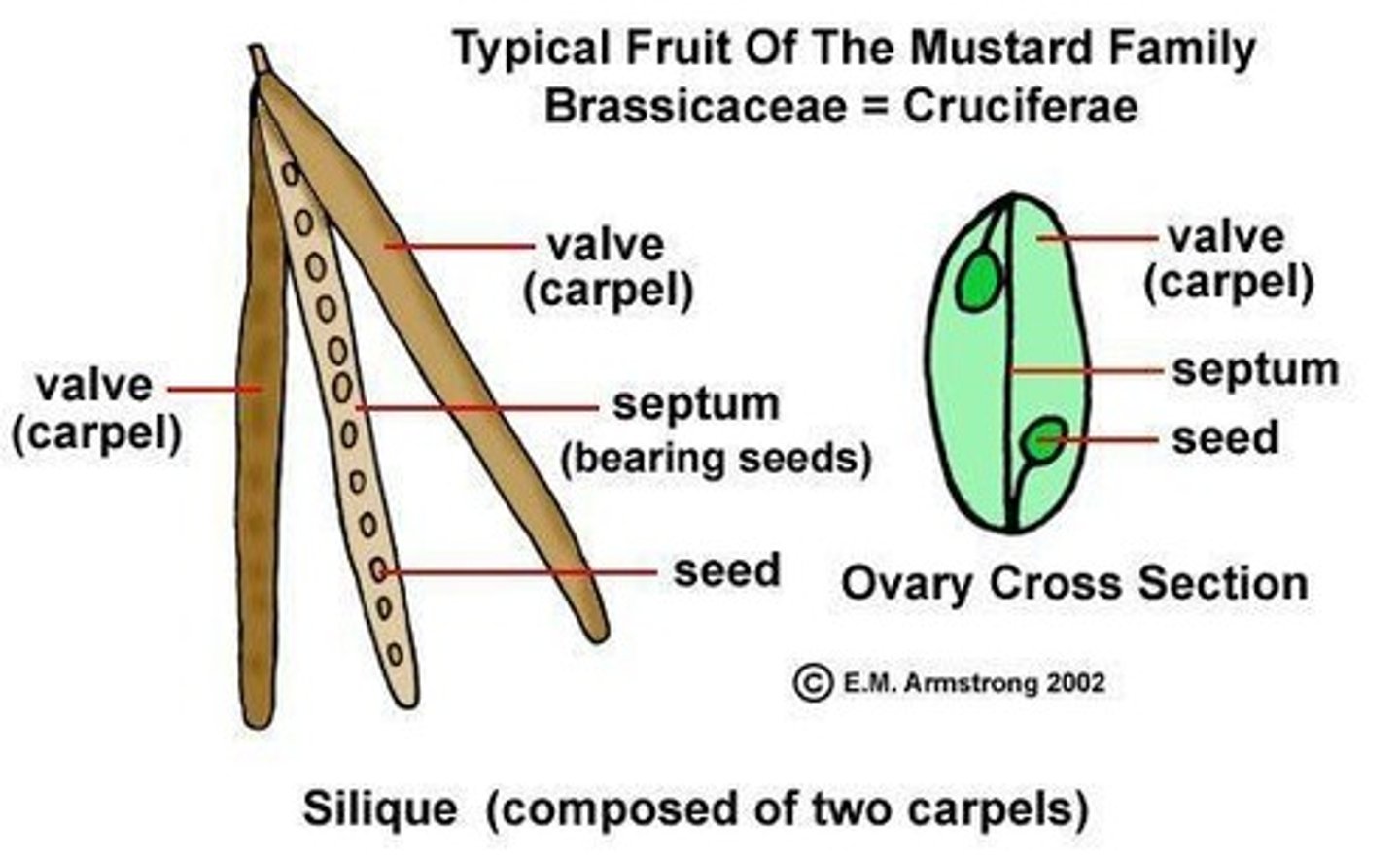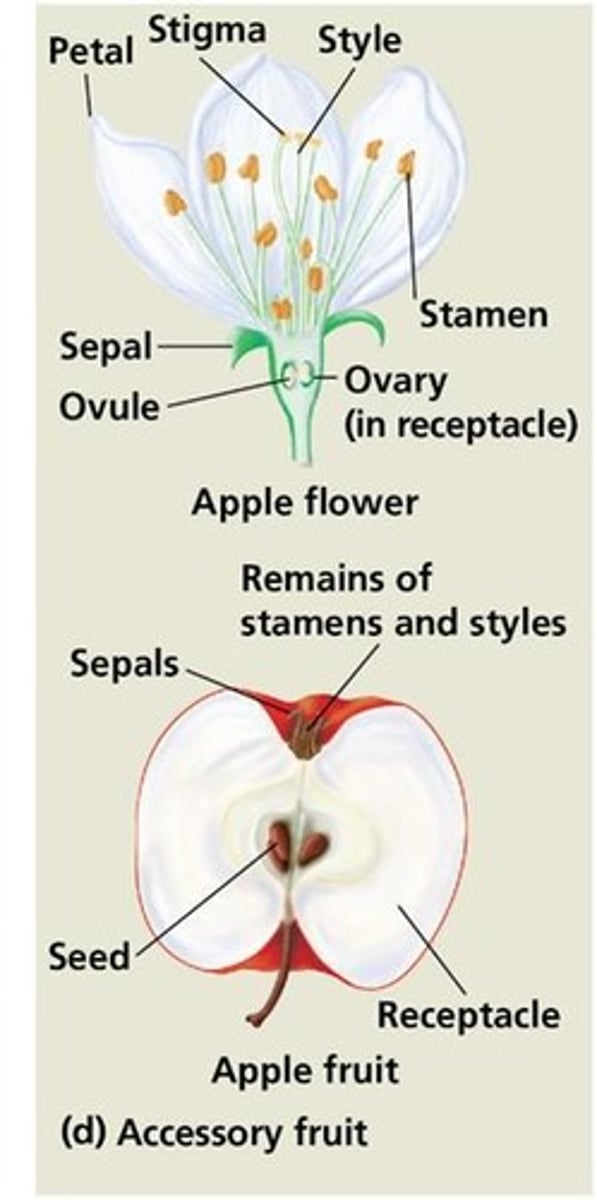Plant Biology: Fruits, Seeds, and Meristem Growth
1/42
There's no tags or description
Looks like no tags are added yet.
Name | Mastery | Learn | Test | Matching | Spaced |
|---|
No study sessions yet.
43 Terms
What is the botanical definition of a fruit?
A fruit is the mature ovary of a flower, produced by angiosperms, that protects seeds and aids in their dispersal.
What are some common examples of fruits in everyday usage?
Examples include plums, peaches, and grapes.
Which structures commonly referred to as vegetables are actually fruits?
Examples include string beans, eggplant, okra, squash, tomatoes, and cucumbers.
How are fruits classified based on their development?
Fruits are classified as simple, aggregate, or multiple fruits.
What is a simple fruit?
A simple fruit develops from a single carpel or several fused carpels of one flower and can be fleshy or dry.
What distinguishes dehiscent from indehiscent dry fruits?
Dehiscent fruits open to discharge seeds, while indehiscent fruits do not.
What is an aggregate fruit?
An aggregate fruit develops from many separate carpels of one flower, such as raspberries and blackberries.

What is a multiple fruit?
A multiple fruit develops from many carpels of many flowers that form an inflorescence, like pineapples and figs.

What is an accessory fruit?
An accessory fruit develops largely from tissues other than the ovary, such as strawberries and apples.
What is parthenocarpy?
Parthenocarpy is the development of fruit without fertilization, resulting in seedless fruits.
What are some examples of cultivated parthenocarpic fruits?
Examples include grapes, eggplants, navel oranges, bananas, pineapples, and seedless watermelons.
What is the difference between vegetative and stimulative parthenocarpy?
Vegetative parthenocarpy occurs without pollination, while stimulative parthenocarpy requires some form of stimulation, like the use of dead pollen.
What adaptations do fruits have for seed dispersal?
Fruits have adaptations for dispersal by wind, water, and animals, including winged fruits and fleshy fruits that attract animals.
What are some mechanisms of wind dispersal for seeds?
Mechanisms include winged and plumed fruits, as well as ballistic dispersal through violent dehiscence.
What role do animals play in seed dispersal?
Animals can aid in dispersal through attachment strategies or by consuming fleshy fruits and excreting the seeds elsewhere.
What is the significance of finding fertile ground for seeds?
Seeds that fall and sprout beneath the parent plant face competition for nutrients, so dispersal is crucial for survival.
What are meristems in plants?
Meristems are regions of undifferentiated cells in plants that are responsible for growth.
What are the two types of growth associated with meristems?
Primary growth, which increases length, and secondary growth, which increases thickness.
What is the role of the ovary in fruit development?
The ovary develops into the fruit, while the ovules within become the seeds.
What is a silique?
A silique is a type of dry fruit having two fused carpels with a length more than three times its width.

What is the fleshy part of an apple derived from?
The fleshy part of an apple is derived from the receptacle tissue of the flower.
What are achenes in strawberries?
Achenes are the tiny individual fruits embedded in the enlarged fleshy receptacle of a strawberry.

How do plants ensure seed dispersal?
Plants utilize both biotic (animal) and abiotic (water and wind) agents for dispersal.
What is the function of the pericarp in fruits?
The pericarp is the part of the fruit that develops from the ovary wall and can play a role in seed protection and dispersal.
What is the primary method of seed dispersal for the winged seed of Alsomitra macrocarpa?
It glides through the air in wide circles when released.
What are common modifications for wind dispersal of seeds?
Winged and plumed fruits, and ballistic dispersal through violent dehiscence of the pericarp.
How do dandelion seeds disperse?
They are carried aloft by the wind using umbrella-like parachutes made of branched hairs.
How does the winged fruit of a maple aid in seed dispersal?
It spins like a helicopter blade, slowing descent and increasing the chance of being carried by horizontal winds.
What is the dispersal method of tumbleweed?
It breaks off at the ground and tumbles across the terrain, scattering its seeds.
How can some buoyant seeds survive at sea?
They can float for many days and germinate when washed onto a sandy beach after being leached of salt by rainwater.
What is a notable characteristic of coconut seeds?
They are large and buoyant, capable of floating hundreds or thousands of miles in seawater.
How do flash floods contribute to seed dispersal in plants like the smoke tree and desert willow?
Flash floods carry hard seeds away from the parent plant and scarify them against rocks, making them receptive to germination cues.
What role do fruits play in seed dispersal?
Fruits protect seeds and influence the timing of germination, but there is no nutritional relationship between the fruit and the seeds.
What is the average caloric value of seeds and fruits compared to other plant tissues?
Seeds and fruits have an average caloric value of ~5100 kcal per gram dry weight, compared to 4000 kcal/g for leaves, roots, and stems.
How do animals contribute to seed dispersal?
Animals like squirrels hoard seeds in underground caches, and seeds in edible fruits are dispersed in feces.
What is the function of the sharp spines on puncture vine fruits?
They can pierce bicycle tires and injure animals, dispersing seeds when the painful tacks are removed.
How do ants assist in seed dispersal?
Ants are attracted to seeds with food bodies, carry them to their nests, and leave the seeds to germinate after consuming the food body.
What are the four types of plant meristems?
Shoot apical meristem, root apical meristem, lateral meristem, and intercalary meristem.
What is primary growth in plants?
It refers to the increase in length of shoots and roots driven by cell division in the shoot apical meristem.
What is secondary growth in plants?
It occurs in lateral meristems and facilitates growth in thickness or girth in maturing plants.
How can annual rings in trees be used?
They can determine the age of a tree and indicate the growth rate during each growing season.
What are the two components of an annual ring?
Springwood (earlywood) with larger diameter cells, and summerwood (latewood) with smaller diameter cells.
Where do intercalary meristems occur, and what is their function?
They occur at the bases of leaf blades and nodes in monocots, allowing leaf blades to elongate after mowing.